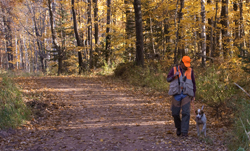Sights of southwest Georgia
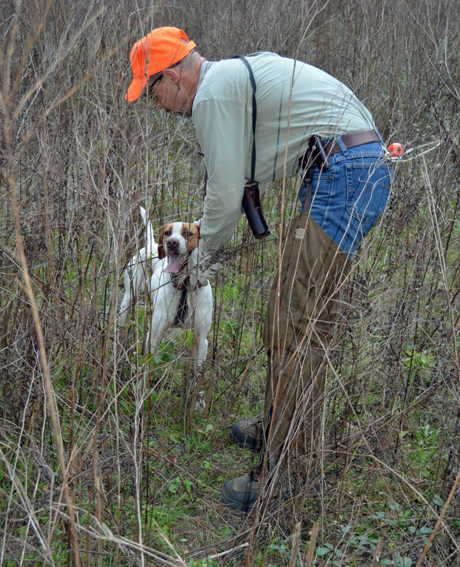
The most common sight here in southwest Georgia is Jerry out working dogs…and when he’s training Northwoods Vixen, our young pointer, it becomes one of my favorite sights.
There is very little about southwest Georgia that resembles home. The woods and lakes of Minnesota seem far away—not only in miles but in cultural differences. Obvious anomalies include no snow and no SA convenience store on every corner. The agricultural landscape consists of peanut and cotton fields and vast groves of large pecan trees; no corn or soybean fields in sight. Sometimes it’s even difficult to grasp that this is part of the United States and people here vote for the same president.
Other basics are different, too. For example:
• Rather than neighborhoods and communities full of beige vinyl-sided houses, here the majority of homes are adorned with brick, usually some shade of red brick. Architectural features such as shutters and front porches (complete with rocking chairs) are ubiquitous. Few homes have garages and even less has basements.
• In the upper Midwest, not many broadleaf evergreen plants grow. The landscape here looks green even in January due to the plethora of big live oaks and many shrubs including camellias, kalmias and hollies. Turf grass is even green in winter.
• Winters are very mild with highs in the 50s, 60s and 70s. Snow is extremely rare. It’s now spring and the sunny, crisp days are more reminiscent of falls days in the north.
• Speech varies from an incomprehensible dialect to typically southern expressions. Truly, I have, quite politely, asked people to repeat themselves because I haven’t understood one word they said. Almost everyone uses “you-all” although, with their drawl, it becomes a single syllable word pronounced like the two-masted sailboat, the yawl.
Even so, Jerry and I have loved living here. We have met some extraordinary people, all of whom exude graciousness and warmth. Many are courteous to a fault with lots of “Ma’ams” thrown into the conversation.
Even more than normal, our meals are highlights of our days as we eat what locals eat. We’ve had grouper and shrimp from the Gulf, catfish, BBQ, biscuits, grits, cornbread, hush puppies and pecans in bars and pies. From nearby Florida, we’ve eaten terrific grapefruit, tomatoes and strawberries. Jerry has even tried and enjoyed sautéed turnip greens.
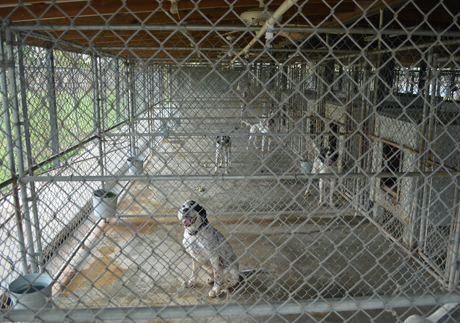
The dogs, seemingly, like it here, too. Each has a spacious kennel run (5’ wide by 10’ long) and an elevated dog house that is just the right size—cozy yet large enough to allow for air flow on warm days. Not one dog has become ill with intestinal problems, tick-borne diseases or other issues. The training opportunities on wild coveys of quail and, when necessary, on liberated Johnny-house quail have been excellent.
Here are some of our favorite sights of southwest Georgia.
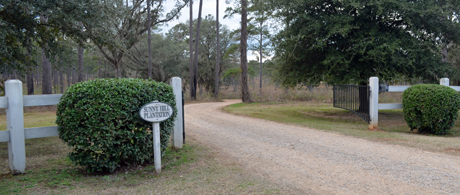
A classy aspect of most plantations is a simple, understated entrance.
Southwest Georgia, and particularly Thomasville, is the center of quail plantation country. Highways (Plantation Parkway), art festivals (Plantation Wildlife Arts Festival) and businesses (Plantation Propane & Petroleum) are named in their honor. Quail plantations themselves have names, too. Many are Native American in origin—Seminole, Cherokee, Osceola and Kickapoo, while others are evocative: Sunny Hill, Twin Oaks, Mistletoe, Longpine, Dixie.
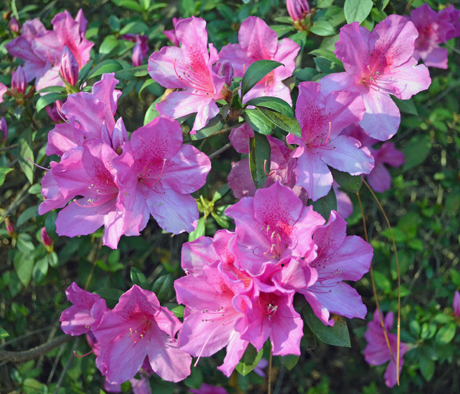
Evergreen azaleas are in full, glorious bloom now. Azaleas belong here in the piney woods of the Red Hills region and prove it by happily putting out hundreds of flowers on a single shrub. The most common flower color is deep pink but I’ve seen shrubs with blossoms of light pink, peach and white.
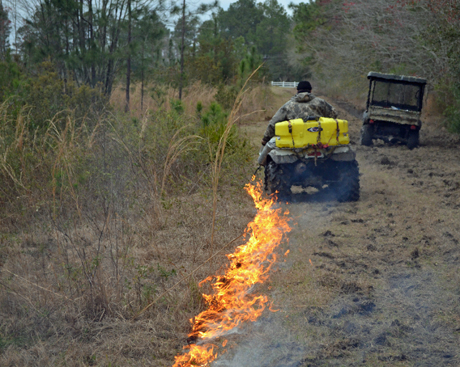
Elements for a successful burn on a quail plantation include: one guy on a four-wheeler with drip torch that ignites the brush, water supply in yellow container and furrowed row that serves as a fire break.
Longleaf pine (Pinus palustris) is the dominant plant of the once-extensive southeast forest that originally (pre-Euopean settlement) comprised an estimated 90 million acres. The stands were rich in numbers of vascular plant species—second only to the tropics—and relied on the natural phenomenon of lightning-started fire for management. Fire continues to be important but now must be set with special permits.
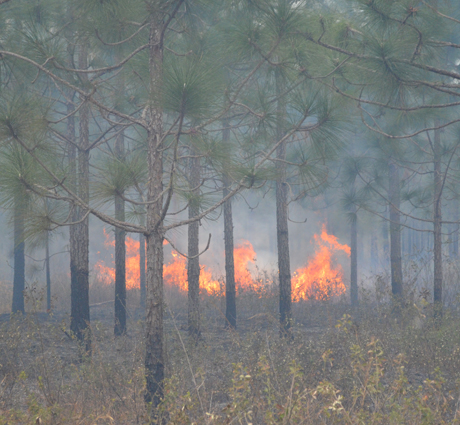
Thick bark on mature longleaf pines makes them resistant to fire.
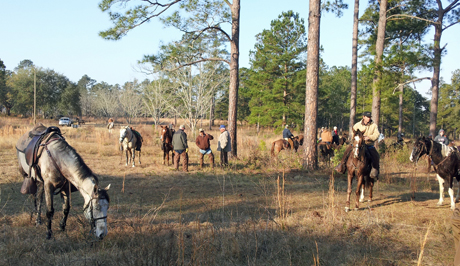
Some of the nation’s most prestigious shooting dog and all-age field trials—the Masters, Continental, Florida, Free-For-All and the National Open Shooting Dog—are held during January, February and March in this part of the country. A huge draw is the opportunity to run on wild bobwhite quail.

Pots of herbs and a garland of cotton adorn the front of Liam’s Restaurant in downtown Thomasville.
Brick-paved, downtown Thomasville is charming and lively. The buildings have been completely renovated and all now bear a plaque noting the original business name and date. Benches and large container gardens full of blooming petunias and pansies line sidewalks and lovely wrought iron signs mark the streets. In homage to its quail plantation heritage, bronze statues of sporting dogs and 12 bobwhite quail are in various locations. Jerry and I discovered some terrific restaurants: Jonah’s Fish & Grits, Sweet Grass Dairy & Cheese (& wine!) Shop, Liam’s Restaurant, Savannah Moon Bakery & Café and Grassroots Coffee Shop. No trip downtown is complete without checking out Kevin’s, a very classy store with hardwood floors and old glass cases that sells premium firearms, outdoor gear, sporting apparel and fine china and crystal.
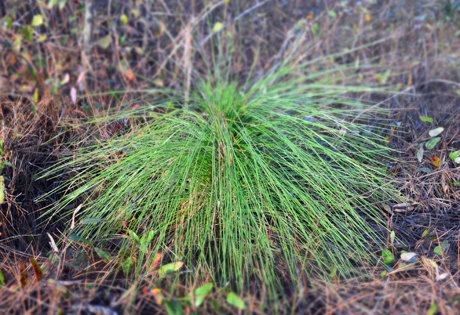
Jerry and I developed an affinity for native longleaf pine (Pinus palustris), the stately evergreen that dominates the landscape in southwest Georgia. The longleaf has a unique start to life. Up to about six years of age, most of the growth takes place below the ground; all that shows above is a very cute, dense cluster of needles that looks more like a grass and, in fact, is termed the “grass” stage. Those needles also protect the young plant from fire.

Mornings in the piney woods are beautiful and May, our Labrador retriever, and I loved the daily walks around our place.
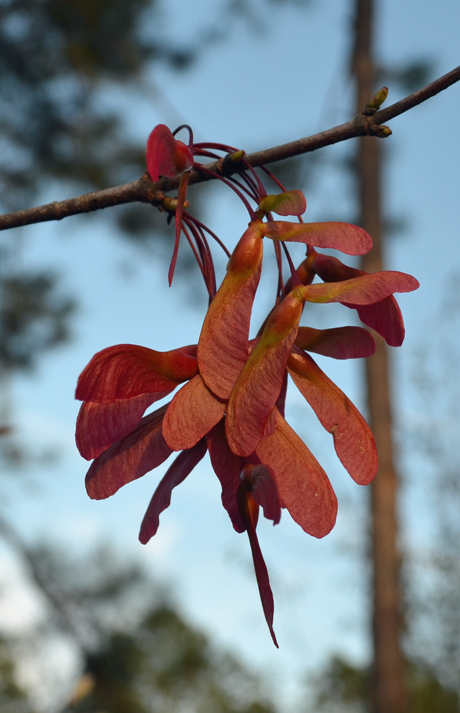
I was surprised but happy to see one familiar tree even though it bloomed about two months earlier than at home. In mid February, red maples (Acer rubrum) became noticeable due to the spectacle of red flowers along bare branches. Tiny samaras soon formed. Red maples have a huge range—among the most abundant and widespread of eastern trees—from northern Maine to the southern tip of Florida.




